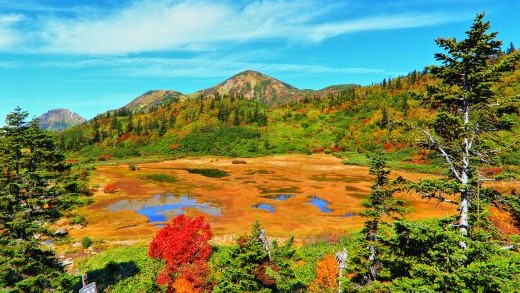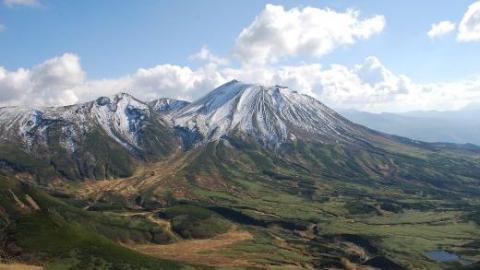
*To watch the video in full screen, please click play and then the YouTube icon on the lower right-hand corner.
What if a single country contained Switzerland’s alpine meadows, California’s redwood forests, Iceland’s volcanoes, Northern Canada’s placid lakes, Hawaii’s tropical beaches, and the Sahara desert’s sand dunes? It sounds like a nature-lovers daydream, but in a way, this fantasy is realized in the form of Japan.
For most first-time visitors to Japan, their top destinations might include bustling cities like Tokyo, or ancient historical centers like Kyoto. But for those with a love for the great outdoors, there is so much more to discover in Japan’s diverse and beautiful natural spaces, particularly in the country’s national parks. And while Japan is well known for its enormous expanse of verdant forests, which cover an estimated 70% of the country, there are many other types of wildlands. The 34 official national parks stretch across the Japanese archipelago, spanning a vast array of climates, landscapes, and wildlife — with a great deal of rich cultural heritage as well. In a time when ecological concerns are a global priority, Japan’s national park system illustrates a unique model of how to balance care for nature while serving local communities through sustainable tourism.
Many countries began developing national parks around the turn of the 20th century in response to increasing urbanization and industrialization — starting with the designation of Yellowstone National Park in the United States in 1872. In Japan, the history of national parks dates back to 1911, when concerned citizens first began lobbying for the recognition of the mountain town and historic shrine of Nikko as an “Imperial Park.” It took another 20 years for Japan’s National Parks Act to be enacted in 1931, with the first three national parks officialized in 1934. In 1957 the Parks Act was revised and expanded, resulting in the system which continues to this day — classifying parks in three categories of national parks, quasi-national parks, and prefectural natural parks. As of 2020, the current count is 34 official national parks, each with their own unique features, but that also reflect the special characteristics of Japan’s environment and history as a whole.
First and foremost, there is the wide spectrum of ecosystems found in Japan due to its shape and position. Japan extends over 3,000 kilometers long from roughly north-to-south, with its northernmost tip near Russia, and its southwestern-most in the Philippine Sea. Imagine driving from Alaska to Acapulco — that’s nearly the breadth of temperatures, topographies, and biodiversity covered by the territory of Japan. But Japan is also relatively “narrow” in its landmass (nowhere in the country is more than 150 kilometers from the ocean), covered with mountains and forests, leaving a relatively small percentage of the landmass which has been historically used for agriculture and habitation. This means that most of Japan’s national parks are much smaller in size than their counterparts in other countries. Alaska’s Denali national park, for example, is over 6 million square acres, while Japan’s largest park by land mass, the mountainous Daisetsuzan in Hokkaido, is about a half million square acres, and most parks are far smaller.

This connects to another fascinating quality of Japan’s parks: how they encompass both nature and human settlements in a symbiotic blend. Compared to parks elsewhere that are set aside solely for wildlife and meant to be pristine “preserves” without permanent residents, the philosophy of the Japanese park system is quite different. In many cases, the parks were formalized in areas where there had already been human communities residing there for centuries, living closely with the land. The government recognized not only that it would be unethical to displace these communities, but that the inhabitants could play a crucial role in sustaining the ecosystem, and in sharing their cultural lifeways that prize harmony with nature. Today about a quarter of the national park lands are privately owned, with hundreds of thousands of residents living there full time.
One example is Akan-Mashu National Park in Hokkaido, a northern forested area that is home to the indigenous Ainu people. Visitors can not only explore the mountains and take advantage of the famous skiing, hiking, and canoeing, but also visit the Ainu settlement near Lake Akan to learn about their traditional culture which prizes nature and animal spirits such as bears. Through arts and crafts, performances, and activities like soaking in hot springs or onsen (a traditional health remedy for the Ainu), travelers from big cities and more fast-paced lifestyles can experience first-hand the connection to the environment that is a concrete way of life for these communities.

Another is Kansai’s Ise-shima National Park, not far from Kyoto, a rugged coastline famous for the historic Ise shrine, as well as its iconic female pearl divers known as “ama.” These women continue a legacy of sea-foraging that dates back millennia, and around a century ago, pioneered cultivated pearls.

Further down the archipelago in Okinawa, Keramashoto is known as an aquatic paradise — attracting scuba divers, kayakers, swimmers and snorkelers. But an influx of tourists has taken its toll on the ecosystem. In recent years, a program forging deeper collaboration with the local fishing community, whose families have been islanders for generations, has empowered them to set limits on the coastline’s use and spread awareness about impact.

These are just a few case studies of how Japan’s national parks have forged a fresh, yet deeply culturally rooted, vision of humans cohabiting with nature. As the national park system approaches its centennial anniversary, it can serve as an example for communities and governments worldwide that are seeking new inspirations in sustainable development and eco-tourism, as well as travelers who want to tread lightly in search of adventure. The parks are a reminder that even for the busiest city-dwellers, adventure, and a whole new mindset, are there waiting, just off the beaten track.
*To watch the video in full screen, please click on the image above, then click on the YouTube icon on the lower right-hand corner.
Related Program
Limited Time Display | The National Parks of Japan
– Stories to Experience –
Date
09.11.2021 (Sat.) ― 11.28.2021 (Sun.)
Location
JAPAN HOUSE, Level 2
Fee
Complimentary

